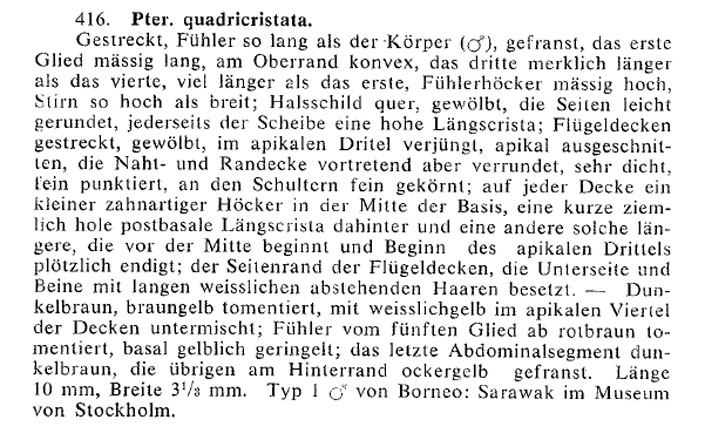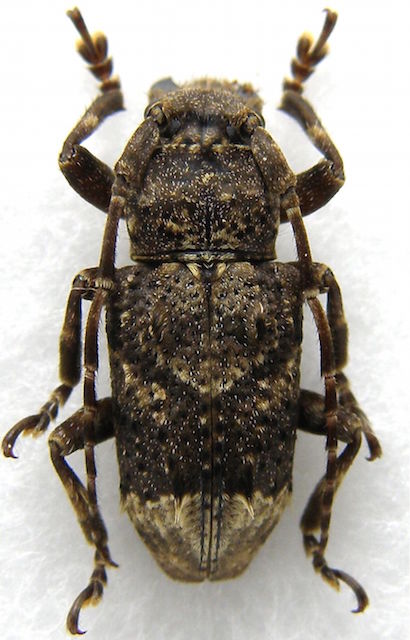| Author |
 Topic Topic  |
|
|
nicky
Member Purpuricenus
 
Singapore
211 Posts |
|
|
loongfah
Member Purpuricenus
 
Singapore
376 Posts |
 Posted - 10/01/2017 : 06:34:41 Posted - 10/01/2017 : 06:34:41



|
| Beautiful shots. It seems quite near to Pterolophia quadricristata Breuning, 1937 |
 |
|
|
Xavier
Scientific Collaborator
    
France
12338 Posts |
 Posted - 10/01/2017 : 09:12:59 Posted - 10/01/2017 : 09:12:59



|
| P.quadricristata is from Borneo. Does it exist in Singapore? |
 |
|
|
loongfah
Member Purpuricenus
 
Singapore
376 Posts |
 Posted - 10/01/2017 : 12:38:15 Posted - 10/01/2017 : 12:38:15



|
| No, it has not been recorded from Singapore before, though the fauna in Singapore is very under-studied. |
 |
|
|
nicky
Member Purpuricenus
 
Singapore
211 Posts |
|
|
Xavier
Scientific Collaborator
    
France
12338 Posts |
 Posted - 12/01/2017 : 09:31:30 Posted - 12/01/2017 : 09:31:30



|

131.7 KB
from BREUNING S., 1938. Novae species Cerambycidarum VI. page 334.
Is it ok with the specimen, Loongfah ? I do not read German. |
 |
|
|
Beckey
Member Rosalia
  
Japan
553 Posts |
 Posted - 12/01/2017 : 13:08:38 Posted - 12/01/2017 : 13:08:38



|
Same species from Malaysia, Negeri Sembilan.

61.36 KB |
 |
|
|
loongfah
Member Purpuricenus
 
Singapore
376 Posts |
 Posted - 12/01/2017 : 15:16:09 Posted - 12/01/2017 : 15:16:09



|
Thanks Xavier for reproducing the description! With the help of Google translate and my own interpretation/correction, the passage is roughly translated as:
Elongate. Antenna as long as the body (male), fringed with hair, the first segment moderately long, convex on the upper edge, the third noticeably longer than the fourth, much longer than the first, antennal socket protuberance moderately high, frons as high as broad; pronotum transverse, arched, the sides slightly rounded, on each side of the disk a high longitudinal crest; elytra elongate, arched, attenuated in the apical third, apically truncate, the sutural and marginal corners protruding but rounded, very densely, finely punctate, shoulders finely granular; on each disc a small tooth-like bump in the middle of the base, a short rather high(?) postbasal longitudinal crest behind it, and another such longer, beginning before the middle and ending abruptly at the beginning of the apical third; Lateral edge of the elytra, the underside and legs with long whitish projecting hair. Dark brown, brown-yellow tomentated, interspersed with whitish-yellow in the apical quarter of the disc; Antennae from the fifth segments tinted red-brown, basal yellowish; The last abdominal segment dark brown, the others at the rear margin ocher yellow fringed. Length 10 mm, width 3.33 mm.
Seems possible (other than the elytra apex?), but difficult to ascertain without the specimen at hand. Perhaps Shinichi can check his specimen? |
 |
|
|
Beckey
Member Rosalia
  
Japan
553 Posts |
 Posted - 15/01/2017 : 13:41:40 Posted - 15/01/2017 : 13:41:40



|
| Could you wait some days, please? |
 |
|
|
sangamesh
Member Purpuricenus
 
India
426 Posts |
 Posted - 15/01/2017 : 19:58:52 Posted - 15/01/2017 : 19:58:52



|
I just want to share my opinion on this specimen identity...I think this may not be P. quadricristata... going with the translated description contributed by Loong Fah, it speaks of some high longitudinal crest on pronotal disc…Elytra with finely granular shoulder…Elytral disc with small tooth-like bump in the middle of the base etc… none of which correspond to this specimen posted here...
I was just curious and wanted to know if Breuning (1965) Key works for this Pterolophia...It turns out that I arrived to the species P. capreola (Pasc.1865)...whose description kind a perfectly match with the specimen posted here...Further I also cross checked with the original description provided by Pascoe where he has key'd this species at 6 th couplet as "Elytra not abruptly declivous, each with two short tufts or crests"...original description can be seen here...and the description given by Breuning in his Revision can be roughly translated as below:
General Body: Long and elongated
Antennae: somewhat shorter than the body and fringed beneath; scape relatively thick, triangular, closely and finely punctured; third segment longer than fourth and first; tubercles slightly protruded.
Gena: half longer than the lower eye lobes; Frons: wider than long.
Pronotum: short, arched, laterally rounded, very dense And finely dotted, with small discal tubercles; scutellum very broad and apically rounded.
Elytra: long, arched, apical very slightly truncated; on each elytron with post-basal dark brown tuft of hairs and similar tuft of hairs also present post-medially and two slightly raised discal longitudinal lines; all punctures on elytra with tiny bright setae arising from them.
Coloration: Brown, reddish-brown, mixed with yellowish tint; Scutellum dark brown with sides yellow; Pronotum at the base with one each Short, yellow longitudinal bands; On each elytron a transverse elliptical, yellowish mark before the post-median hair fascicle and follwoed by a small dark brown mark apically; antennomeres from 3 to 11 basally and apically ringed with yellowish pubescence.
These characters perfectly match I suppose...concerning the ambiguity associated with Breuning's work I'm not sure whether it is the same species, but, to me the description of capreola matches with this specimen...
|
Edited by - sangamesh on 15/01/2017 20:38:46 |
 |
|
|
Xavier
Scientific Collaborator
    
France
12338 Posts |
 Posted - 16/01/2017 : 11:12:07 Posted - 16/01/2017 : 11:12:07



|
I think it could be this species: Pterolophia annulitarsis (Pascoe, 1865)
Description associate to the picture. |
Edited by - Xavier on 16/01/2017 11:13:01 |
 |
|
|
Beckey
Member Rosalia
  
Japan
553 Posts |
 Posted - 17/01/2017 : 11:11:07 Posted - 17/01/2017 : 11:11:07



|
| Perfect! |
 |
|
|
loongfah
Member Purpuricenus
 
Singapore
376 Posts |
 Posted - 17/01/2017 : 13:50:04 Posted - 17/01/2017 : 13:50:04



|
| Thank you, Xavier! |
 |
|
| |
 Topic Topic  |
|


